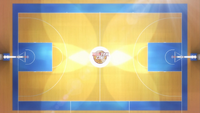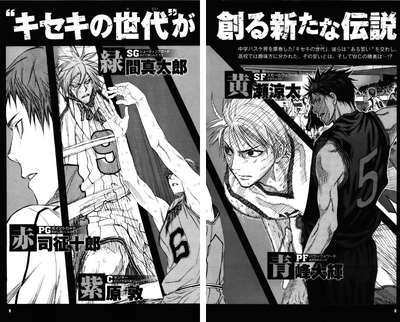Basketball is a team sport in which two teams of five players try to score points by throwing or "shooting" a ball through the top of a basketball hoop while following a set of rules. Basketball is one of the world's most popular and widely viewed sports.
Basic rules
A regulation basketball hoop consists of a rim 18 inches (45.7 cm) in diameter and 10 feet (3.05 m) high mounted to a backboard. A team can score a field goal by shooting the ball through the hoop during regular play. A field goal scores two points for the shooting team if a player is touching or closer to the hoop than the three-point line, and three points (a "3 pointer") if the player is "outside" the three-point line. The team with more points at the end of the game wins, but additional time (overtime) may be issued when the game ends with a tie. In the anime, it is based on FIBA rules of 10 minutes per quarter, with 5 fouls causing an ejection. The ball can be advanced on the court by bouncing it while walking or running (dribbling) or passing it to a teammate. It is a violation (traveling) to walk with the ball, carry it, or to double dribble (to hold the ball and then resume dribbling).

Basketball court
Various violations are generally called "fouls". Disruptive physical contact (a personal foul) is penalized, and a free throw is usually awarded to an offensive player if he is fouled while shooting the ball. A technical foul may also be issued when certain infractions occur, most commonly for unsportsmanlike conduct on the part of a player or coach. A technical foul gives the opposing team a free throw.
Basketball has evolved many commonly used techniques of shooting, passing, and dribbling, as well as specialized player positions and offensive and defensive structures (player positioning) and techniques. Typically, the tallest and strongest members of a team will play the "center" or "power forward" positions, while slightly shorter and more agile players will play "small forward", and the shortest players or those who possess the best ball handling skills and speed play "point guard" or "shooting guard".
While competitive basketball is carefully regulated, numerous variations of basketball have developed for casual play. Competitive basketball is primarily an indoor sport played on carefully marked and maintained basketball courts, but less regulated variations are often played outdoors in both inner city and rural areas.
Positions
Although the rules do not specify any positions whatsoever, they have evolved as part of basketball. During the first five decades of basketball's evolution, one guard, two forwards, and two centers or two guards, and one center were used. Since the 1980s, more specific positions have evolved, namely:
- Point guard: usually the fastest and shortest on the team. Takes command of the team and calls the play. Usually has good ball handling and a good shot. Passing skills, steals and court vision are characteristic abilities of point guards. Notable PGs are Seijūrō Akashi, Makoto Hanamiya, and Shun Izuki.
Notable point guards from the NBA past and present: Oscar Robertson, Magic Johnson, John Stockton, Jason Kidd, Steve Nash, Chris Paul, Stephen Curry - Shooting guard: creates a high volume of shots on the offense, and is responsible for guarding the opposing teams shooter as well. They take many shots; especially 3 pointers, and are able to cut to the basket as well. Notable SGs are Shintarō Midorima, Reo Mibuchi, and Junpei Hyūga.
Notable shooting guards from the NBA past and present: Michael Jordan, Reggie Miller, Kobe Bryant, Ray Allen, Dwyane Wade, James Harden, Klay Thompson. - Small forward: not big enough for center, too slow to be a point guard. A very well rounded player, can do everything any other position can do, just not as well. They're very fast and strong, however they're not fast or strong enough for the other positions. Notable SFs are Ryōta Kise, Kotarō Hayama, and Shōgo Haizaki. Even though Kuroko's position is noted as a question mark, his assumed positions would be closest to small forward out of the five.
Notable small forwards from the NBA past and present: Larry Bird, Scottie Pippen, LeBron James, Kevin Durant, and Carmelo Anthony. - Power forward: are extremely tall big men or wide shorter men, typical power forwards are not fast or good jumpers. They play a very center-like way, and are very crafty. They are typically faster than a center, but not faster than a small forward. With good strength, some are able to power out a center. Many power forwards in the NBA can be used as centers, or may be the tallest players in the team, but with slimmer build than centers, so they start as PFs. Notable PFs are Daiki Aomine, Taiga Kagami, and Chihiro Mayuzumi.
Notable power forwards from the NBA past and present: Karl Malone, Dennis Rodman, Charles Barkley, Tim Duncan, Anthony Davis and Dirk Nowitzki. - Center: are most if not always the tallest on the court. Ranging from 6'10 and above, they use height and power to score points and hustle for boards. Great centers come with a variety of post moves, most are not unable to shoot 3 points consistently, but can make mid range jumpers. Notable Cs are Atsushi Murasakibara, Teppei Kiyoshi, and Eikichi Nebuya.
Notable centers from the NBA past: Kareem Abdul-Jabbar, Wilt Chamberlain, Bill Russell, David Robinson and Hakeem Olajuwon and Shaquille O'Neal. Notable centers from the NBA present: DeMarcus Cousins, Andre Drummond, Marc Gasol, DeAndre Jordan and Tyson Chandler (who, due to his small frame when he entered the NBA, he started as an oversized SF)
The above descriptions are flexible. For most teams today, the shooting guard and small forward have very similar responsibilities and are often called the wings, as do the power forward and center, who are often called post players. While most teams describe two players as guards, two as forwards, and one as a center (or 2 guards, 1 swingman (SG/SF) and two big men (PF/C), or even two centers), on some occasions teams choose to call them by different designations. There are even exceptional cases where taller forwards cover the point guard spot (point-forward like Scottie Pippen late in his career).
While the positions are not enforced, they are usually the best route to win games. Some teams may use something called a 'small' lineup, where they take out the center and occasionally the power forward to create a lineup of small and quick players. It's highly effective if used in the correct scenario.
| This page uses Creative Commons Licensed content from Wikipedia (view authors). |
In Kuroko no Basuke
Basketball plays an important role in Kuroko no Basuke, as it is the main theme. All the characters that have appeared either play basketball, are coaches or are managers. The manga only focuses on high school basketball, with teams from different schools competing against each other. These teams compete in tournaments, like the Interhigh, the Winter Cup and the Nationals. This basketball scene mainly takes place in Tokyo.

